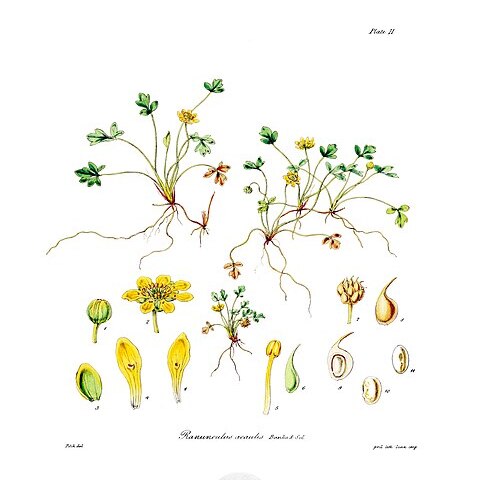Low-growing, fleshy, glab. plant creeping by white underground stems, rooting at nodes and emitting tufts of lvs (stems occ. appearing above ground and becoming green, but us. 2-4 cm. deep in sand); internodes ± 5 cm. long. Lvs all radical on slender petioles 2.5-5-(8) cm. long; sheath membr.; lamina 1-2 cm. diam., dark green, 3-foliolate to deeply 3-lobed; Iflts sessile, obovate to oblong, entire to 2-3-lobed or toothed, ± 5 mm. diam. Scapes up to 2 cm. long, nude, slender, 1-fld. Fls 6-9 mm. diam.; sepals 5, membr., broadly ovate; petals 5-8, yellow, spathulate; gland 1 near middle. Fruiting heads 6-9 mm. diam.; achenes turgid, glab., ovoid, ± 2 mm. long; styles straight, subulate, ± 1 mm. long.
Perennial; rosettes tufted along pale, spreading, slender rhizomes. Lvs long-petiolate; lamina 3-foliolate or deeply 3-lobed, fleshy, glabrous, 1-2-(3) cm diam.; terminal lobe usually 3-fid, rounded to obtuse at apex, lateral lobes entire or with 1 basiscopic lobe. Fls solitary, 5-10 mm diam.; peduncles glabrous. Sepals spreading, glabrous. Petals 5-8, yellow, spathulate; nectary single, 1.5-2 mm from petal base, pocket-like. Receptacle glabrous. Achenes 10-30, not flattened, glabrous; body 2-3 mm long; beak straight, 0.5-1 mm long.

